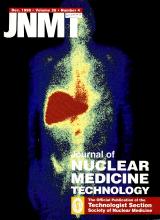Abstract
Objective: This retrospective analysis was designed to optimize the parameters and techniques required to successfully perform high-quality coincidence imaging in a general nuclear medicine department using a dual-headed gamma camera.
Method: Coincidence imaging was performed on 33 patients after an intravenous injection of 3.0–5.0 mCi fluoro-2-deoxyglucose (18F-FDG). Data for all subjects were evaluated to determine which technical considerations contributed to an overall improvement in image quality.
Results: After reviewing the data for the 33 subjects, several modified techniques were implemented and parameters were adjusted that enhanced the overall quality of the images. The extremely short half-life of 18F restricts the opportunity to repeat studies that were delayed, interrupted or technically substandard.
Conclusion: The review of the data indicated that strict adherence to protocol is necessary to achieve optimal results while attempting to incorporate this new imaging modality into a typical nuclear medicine department.







